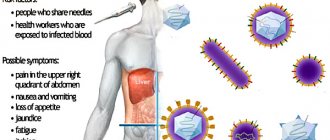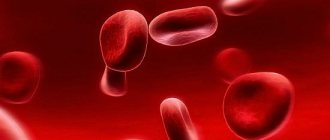Given the asymptomatic course and the high probability of transmission of HCV infection, diagnosis in the early stages of the pathology is of great importance. The polymerase chain reaction is considered the most accurate. Unlike methods for identifying serological markers, PCR depends little on concomitant diseases and the general condition of the patient. But if the hepatitis C virus is confirmed, a quantitative analysis, the interpretation of which is carried out by a doctor, is mandatory.
HCV is a serious disease that requires serious, expensive and dangerous therapy. Therefore, the diagnosis is never made based on the results of one study. If a viral disease is suspected, the patient must undergo several tests. But in order to avoid unnecessary costs and loss of time, blood tests and instrumental examinations are carried out in stages.
The main stages of the diagnostic process are shown in the table:
| Ongoing research | Execution Goals |
| Biochemical blood test and liver tests | Allows you to evaluate the functional activity of the liver, bilirubin levels, and liver transaminases. Exceeding the norm by 2 times or more indicates the presence of a disease |
| Clinical tests of blood, urine and stool | These studies are nonspecific, but the results can determine the presence of an inflammatory process and assess the general condition of the patient. Detection of bilirubin in urine and changes in the color of stool indicate liver damage |
| Enzyme-linked immunosorbent assay (ELISA) | Allows you to determine both the presence of a viral infection in the body and its form (acute or chronic). The disadvantage of the study is the likelihood of false results |
| Polymerase chain reaction | Expensive, difficult to carry out, but at the same time the most accurate method for diagnosing HCV. Allows you to confirm the presence of the virus in the human body, quantitatively determine the level of RNA copies, and determine the HCV genotype |
| Instrumental examinations of the liver | It is necessary to conduct an ultrasound of the abdominal organs, establish the stage of fibrosis, assess the severity of cirrhosis, and exclude hepatocellular carcinoma |
The doctor makes the final diagnosis only based on the results indicated in all studies. Some drugs, for example, hepatoprotectors, vitamins, are indicated already at the beginning of the diagnostic process. But targeted antiviral agents are prescribed after receiving all the data.
What is PCR
The polymerase chain reaction technique has been known for a long time and has been successfully used to diagnose a number of viral diseases, and HCV is no exception.
Currently, there are several methods for performing PCR, but in principle this process consists of several stages:
- Destruction of the double strand of DNA under the influence of heat or certain chemicals.
- Attaching so-called primers to base-separated DNA - remnants of the nucleotide chain of the RNA virus (most modern test systems use the 5'-NTR regions of the HCV genome).
- A specific enzyme, DNA polymerase, recognizes the primer and provokes the addition of other nucleotide residues.
At the end of the third stage of the polymerase chain reaction, the DNA between the two primers is doubled, and subsequently the genome region is amplified in geometric progression (2-4-8, etc.).
The sensitivity of modern test systems is 10–50 copies of RNA in 1 ml of blood.
The interpretation of PCR for hepatitis C must be carried out by a qualified specialist. In accordance with the WHO International Standard, for the quantitative determination of the viral genome, a lyophilized blood plasma sample containing RNA of the first genotype of the virus at a concentration of 105 IU/ml is used.
At the same time, attention is paid to the quantitative units in which the research results are expressed. Typically, HCV RNA copy numbers are reported in absolute or logarithmic terms. Then, in accordance with international standards, this figure is recalculated using a special coefficient into international units (IU). Thus, the final results are indicated in IU/ml.
To conduct a quantitative study, various test systems and polymerase chain reaction methods are used. Some are designed to assess the level of viremia in plasma or serum. Others are more effective and indicative when examining whole blood.
It is not entirely correct to talk about the norm when interpreting the results indicated on the laboratory form. The fact is that a healthy person does not have viral RNA in the body, and the presence of HCV particles, regardless of the quantitative indicator, indicates infection. Subsequently, the effectiveness of treatment is assessed using PCR. If the result is negative at 4 weeks of taking medication, and then after the end of antiviral therapy (for 48 weeks), recovery is indicated.
Types of research
Carrying out a polymerase chain reaction involves determining not only the presence of HCV RNA in the blood, but also determining the number of copies of the virus and analyzing the genome structure. Such capabilities make PCR one of the most informative and accurate methods for diagnosing viral hepatitis C.
All methods of polymerase chain reaction used in practice are given below in the order of execution (each subsequent test is prescribed if the previous one is positive):
- PCR analysis for hepatitis C is qualitative and is carried out only to detect the RNA of the virus in the blood.
- Quantitative PCR study. Decoding is carried out according to generally accepted standards. Depending on the result, the virological load may be low, moderate or high. This indicator is one of the predictors of the outcome of HCV therapy.
- Genotyping (many private laboratories offer it in combination with quantitative analysis, which reduces the overall cost). The HCV genotype is designated by one of the Arabic numerals (1 to 6). On the territory of Russia, genotype 1 or 3 is more often detected, genotype 2 is somewhat less common, 4–6 are diagnosed in isolated cases. Previously, when using interferon treatment regimens, the type of HCV determined the duration and effectiveness of therapy. Modern antiviral drugs have a wide spectrum of action, but some of them are prescribed only for 1–4 HCV genotypes.
Genotyping is performed only once, before starting therapy. As medications are taken, quantitative norms of hepatitis C are necessary for the doctor to assess the effectiveness of antiviral drugs. After completion of the course of treatment, a qualitative PCR study is carried out.
Where can I get a quality PCR test?
So, the answer to the question “ How to take a PCR test for hepatitis C?” " It is also known what the patient should do after the appropriate examination. But one more dilemma remains - where exactly can you donate blood for a qualitative PCR test for hepatitis C?
By and large, in our country you can undergo diagnostics of this type:
- In public clinics;
- In private clinics with exclusive level of service;
- In hospitals and inpatient clinics;
- In independent medical laboratories.
You can also take a hepatitis C PCR blood test in foreign clinics and laboratories. This research method is standard.
Features of quantitative analysis
Quantitative PCR analysis is performed to determine the viral load. This term refers to the number of copies of pathogen RNA in 1 ml of blood.
Thanks to such a study, the doctor will be able to assess a number of factors that play a key role both in the course of the disease itself and in the outcome of therapy. This:
- the likelihood of developing complications (cirrhosis and hepatocellular carcinoma), since the more active the pathological process, the higher the risk of liver pathologies already in the initial stages of hepatitis C;
- the effectiveness of the standard treatment regimen (in severe cases, additional prescription of antiviral drugs is required);
- risk to others (especially if the patient belongs to a socially prosperous segment of the population, has a family, children);
- risk of extrahepatic complications (development of autoimmune diseases, damage to the nervous, cardiovascular systems, etc.).
Quantitative determination of HCV RNA is also important for monitoring the effectiveness of treatment. As you continue to take antiviral drugs, these numbers decrease. The goal of therapy is to achieve a negative result from a qualitative PCR test.
Indications
Before the advent of a large number of private laboratories, where a patient could undergo almost any test without documents from a doctor, a referral to perform quantitative PCR was given at a certain stage of diagnosis or treatment.
In accordance with WHO standards and protocols, indications for such a study are:
- positive serological markers of HCV (anti-HCV Total, presence of immunoglobulins class G and/or M);
- positive result of qualitative PCR;
- control of the treatment.
If desired, the patient can independently go to a private clinic and perform such a study. But in the absence of hepatitis C, such a laboratory test is considered inappropriate.
What stages of the disease do we carry out?
The following deadlines are established for determining the viral load:
- before starting therapy (possibly simultaneously with genotyping);
- 4th week of treatment (negative data indicate a rapid virological response and serve as predictors of a favorable outcome);
- the last week of the therapeutic course (12 or 24 depending on the selected regimen), a negative result confirms the effectiveness of therapy, a positive result requires continued treatment, but with the use of other medications;
- 24 and 48 weeks after the end of the treatment course (regardless of its duration), the absence of viral load confirms recovery.
Additionally, the study is carried out only when indicated (for example, deterioration in health, errors in taking pills, identification of concomitant infections, etc.). Performing PCR does not exclude the need for other tests - clinical studies of blood and urine, liver tests, ultrasound and others.
What is the polymerase chain reaction method?
Polymerase chain reaction is a molecular research technique for determining the genetic material of a viral agent from the first days of infection. The analysis is characterized by a high degree of reliability, specificity, and accuracy. Thanks to it, not only the absence/presence of the virus is detected, but also the viral load (quantitative value) and genotype.
The study requires the patient's blood, which presumably contains the RNA of the viral infection. In laboratory conditions, primers are added to biological fluid - these are short-length artificially synthesized fragments of the desired gene. Plus RNA polymerase is a specialized enzyme that repeatedly increases the concentration of the desired material.
Next, the blood with the addition of components is heated and cooled several times in a special device. Then the results are analyzed and compared with the known genes of the viral agent. Based on this, a conclusion about the disease is made.
Types of PCR research
The PCR test for hepatitis C is carried out in the laboratory with the addition of the necessary reagents, and has three varieties with distinctive characteristics:
- Qualitative PCR analysis for hepatitis C is the first stage of the study. Through it, the genetic material of the pathogen is detected in the blood serum.
- A quantitative study allows you to estimate the viral load - this is the content of viral material in 1 ml of the patient’s blood. It is carried out before the start of treatment, and then after 1-4-12 weeks of therapy. When the course is long, the study should be conducted after 24 weeks of therapy to assess the effectiveness.
- Genotyping. An infectious disease develops rapidly, the virus tends to mutate. Therefore, it is necessary to identify the genotype of the virus.
Scientists have identified 7 genotypes of the virus. In the Russian Federation, 1-2-3 species are more common.
Each genotype is characterized by resistance to treatment.
For example, with type 1, the effectiveness of therapy is about 60%, with types 2-3 the figure reaches 85%.
To select the right medications and duration of treatment, it is necessary to identify not only the fact of infection itself, but also the concentration of the virus and its genotype.
Indications for use
Markers for hepatitis, PCR and ELISA, other studies have certain medical indications:
- When the patient has a history of HIV infection or AIDS.
- Contact with an infected person, since viral hepatitis is highly contagious.
- Symptoms of cirrhosis of the liver are hepatomegaly, an increase in the size of the spleen, a venous pattern appears on the abdomen, etc.
- Clinic of functional liver disorder - periodic/constant pain in the right hypochondrium, yellowing of the skin, nausea.
- High values of AST and ALT in blood biochemistry.
- During pregnancy, when liver test results are poor.
- Before starting an antiviral course, to determine the viral load.
- To monitor the effectiveness of therapy.
- After therapy to prevent recurrence of viral infection.
PCR is performed with a confirmed diagnosis of hepatitis B to exclude a mixed type of liver damage.
Preparation for the study and collection of material
The doctor will tell you how to prepare for the test. To get an accurate result, the patient is recommended to prepare. It consists of the following recommendations:
- The test must be taken in the morning, on an empty stomach. It is allowed to drink only clean, still water before taking blood. The last meal is 8 hours before collection.
- If it is not possible to take the test in the morning, it can be done in the evening or at lunch, the main thing is 5-6 hours after eating, not earlier.
- 48 hours before the test, stop drinking alcohol, caffeine-containing drinks, and juices.
- For 2 days you need to follow a diet, eliminating all harmful foods. However, some doctors believe that fatty, fried foods do not affect the accuracy of the PCR test.
Do not take medications 24 hours before medical procedure. If this is not possible, inform your doctor. The analysis is not recommended to be performed immediately after ultrasound, CT, massage and other physiotherapeutic procedures.
Blood sampling occurs as follows:
- Using a special tourniquet, which is tightened on the patient’s forearm, the physician stops the venous blood flow. The veins become more visible, which makes the procedure for inserting a needle and subsequent blood sampling easier.
- Before inserting a sterile needle, the skin area is treated with an alcohol-containing liquid.
- A needle is inserted into a vein, after which a test tube is attached to it, into which blood flows.
- After insertion of the needle, the tourniquet is removed. The required amount of blood is collected and the needle is removed.
- A cotton swab soaked in alcohol is applied to the injection site.
To prevent the formation of a bruise at the site of needle insertion, you need to press the cotton swab firmly enough to the injured area, bend your arm and hold it in this position for 3-4 minutes.
If the patient is taking medications that thin the blood (Aspirin, Warfarin), there may be some problems stopping bleeding.
How to prepare for research
To ensure that the decoding of the PCR analysis is not erroneous, it is necessary to prepare accordingly for blood sampling. With some exceptions, the rules do not differ from those in other studies.
Necessary:
- donate blood strictly on an empty stomach (last meal 12 hours before visiting the laboratory);
- carry out the procedure in the first half of the day (as early as possible);
- on the day of the test, after waking up, you can only drink water; tea, coffee, carbonated and/or sweet drinks, juices, etc. contraindicated;
- 3–5 hours before donating blood, you should not smoke;
- If it is not possible to stop taking any medications, tell the names of the medications you are taking to the laboratory assistant and the doctor who will interpret the data obtained.
The presence of hepatitis C already implies a complete abstinence from alcohol and a strict diet (table No. 5). But if the analysis is carried out at the diagnostic stage, 5-7 days before blood sampling, nutritional control is required with the exception of foods and alcohol that are difficult for the liver.
Indications for diagnostics
A qualitative study of hepatitis C virus RNA cells is not carried out at the request of the patient; indications for such a procedure can only be:
- Study of tissue grown using biopsy;
- Study of leukemia and malignant tumors;
- Diagnosis of the body for the presence of genetic pathologies;
- Identification of a person by comparing the patient’s biological fluids with available biomaterials;
- Detection of the causative agent of a viral infection (with mixed hepatitis).
In addition, RNA analysis can show an assessment of the effectiveness of the current course of therapy, which is very important in the treatment of a viral disease.
Interpretation of quantitative analysis for hepatitis C
Typically, when a patient receives test results, the form contains the normal values, the values obtained, and a brief interpretation. However, a blood test for hepatitis C should only be interpreted by a doctor. Quantitative PCR is one of the diagnostic stages, so the doctor compares the given numbers with previously obtained results.
Depending on the obtained indicators, the degree of viral load or the complete absence of HCV RNA in the body is determined.
If a quantitative analysis for hepatitis C is carried out, the decoding is carried out in accordance with the table:
| Indicator value | Viral load level |
| No RNA virus was detected (or the number of copies is less than the sensitivity of the test system) | Normal, the person is healthy or the analysis was carried out during the incubation period of the pathology |
| 1.8×102–7.9×105 IU/ml | Low viral load. Indicates recent infection, latency or effectiveness of antiviral drugs |
| 8×102–2.3×107 IU/ml | Moderate viral load. Usually observed in chronic form of HCV. The prognosis for treatment is favorable provided that the doctor’s recommendations are followed |
| 2.4×107 IU/ml and above | High viremia. Severe complications are very likely (even liver cancer) |
In order to accurately decipher the analysis and avoid erroneous results, quantitative PCR data can be assessed only after identifying serological markers of qualitative PCR. For ELISA, the positivity rate must be indicated. Data from ultrasound examination, elastography and biopsy are also taken into account, if the study was carried out.
Norm
Quantitative PCR analysis is performed only if other blood parameters for hepatitis C are positive.
A negative result is possible if:
- independent recovery (medical literature provides statistics according to which about 15% of cases of HCV infection go undetected; the human immune system completely eliminates the virus);
- early virological response (when assessing results during antiviral therapy);
- in case of erroneous data from previous studies (unlikely, since ELISA, high-quality PCR, and liver tests are usually prescribed first).
When a hepatitis C test is taken to assess the virological load, the decoding is carried out by a doctor. It is believed that normal indicators are the complete absence of HCV RNA in the blood. But to exclude a hidden infection, it is recommended to repeat the study after a few weeks.
What blood tests indicate hepatitis C?
Before starting a diagnostic examination, it is necessary to know exactly what blood parameters indicate HCV. On the one hand, this will allow the patient to avoid unnecessary financial expenses for unnecessary tests, on the other hand, it will save time.
So, for hepatitis C, the following data are indicative:
- positive ELISA, regardless of the class of antibodies detected; but this parameter is assessed against the background of other results, since some features of the immune system may affect the accuracy of the study;
- positive qualitative PCR (sensitivity and specificity of the method reaches 100%);
- determination of the number of virus copies using quantitative PCR.
Indirect signs of HCV are excess liver transaminases, bilirubin, leukocytosis, accelerated ESR, and the presence of bilirubin in the urine.
When deciphering the results, abbreviations are taken into account, as hepatitis C is designated in tests. Typically, the viral load is indicated in IU/ml or IU/ml, and the RNA of the virus is indicated by the English abbreviation RNA HCV.
Is there a false test?
Unlike ELISA, the probability of a false PCR result is almost zero. Errors are possible only as a result of the human factor, that is, if the rules for blood sampling, storage of samples and the actual conduct of the study are violated.
Advantages of PCR over other tests
The polymerase chain reaction method has certain advantages over other diagnostic techniques.
The advantages of the study are presented in the table:
| Direct diagnosis of the pathogen | Other studies allow us to answer whether there is a pathogen in the body or not. But using PCR techniques, it is possible to specifically determine the type of viral agent. |
| Specificity of the study | PCR identifies a unique DNA fragment that corresponds to only one type of viral agent. This allows you to minimize the likelihood of error. |
| High degree of sensitivity | Even a tiny concentration of the virus in the blood can be detected. |
| Identification of all pathogens | During the study, all pathogenic agents can be detected. |
| Hidden infections | In addition to the viral pathogen, it is possible to identify infections that have a latent course and are characterized by high antigenic activity. |
When a patient receives a positive result, this will mean that the genetic material of the hepatitis causative agent was detected in the biological fluid. Negative result – there are no traces of the virus.
Advantages of quantitative PCR testing
Experts in the field of hepatology emphasize that quantitative PCR has no analogues and is one of the main studies for patients with HCV. The analysis mechanism minimizes the likelihood of false positive or false negative results.
It takes several days to get results. Blood sampling does not require special preparation, is possible in almost any clinical laboratory and is not accompanied by any significant pain. But the main advantage of such an analysis is its high accuracy, reaching 100%.
General facts about hepatitis C
Hepatitis category C is considered the most dangerous of all types of viral pathologies, since it has a very high tendency to mutate. Once in the body, RNA components constantly change their structure, which is why the immune system cannot independently produce the correct antibodies to naturally cure the disease. This allows the infection to spread without special obstacles.
After a few weeks, the virus mutates to such a state that a person begins to feel the first symptoms, which manifest themselves as:
- Periodic dizziness;
- Nausea, or even vomiting;
- Chronic fatigue;
- Pain in the right hypochondrium;
- Increased body temperature.
After the acute stage, the disease becomes chronic. With the help of drug therapy, the patient can only maintain it during the incubation period, avoiding repeated relapses.
Rules for preparing for PCR diagnostics
Venous blood is taken for analysis: it must be donated in the morning on an empty stomach. When preparing for a PCR test, the patient must exclude:
- food intake - ten hours before the procedure;
- drinking alcohol - the day before the procedure;
- smoking - four hours before the test;
- taking medications - two days before taking blood;
- physical stress and emotional shock.
Explanation of results (table)
After quantitative polymerase chain reaction, data on the viral load on the liver and the body as a whole are displayed in the form. The amount of pathogen RNA is expressed as IU/mL (international units/milliliter). The data is usually displayed in the form of a table, which presents:
- norm of quantitative PCR for hepatitis C;
- the result obtained;
- other parameters.
This is interesting: Hepatitis C: early and late stages of the disease
Viral load values for hepatitis C
| Index | Interpretation |
| Negative | No pathogen RNA was detected in the biological material |
| 0 - 1.8X10^2IU/ml | The amount of genetic material of the virus is below the established reference value |
| 1.8X10^2IU/ml - 8X10^5IU/ml | Low viral load. |
| 8X10^5IU/ml - 2.4X10^7IU/ml | High viral load |
| 2.4X10^7IU/ml or more | The upper limit of values has been exceeded. |
Rates depend partly on the type and sensitivity of the test. Therefore, only a doctor who takes into account all the parameters can decipher the result of the analysis.
The attending physician, based on the test results, the collected medical history, and clinical signs, will select antiviral therapy. Its intensity will depend on the amount of the virus genotype found in the sample.
Decoding
The genetic material of HCV is detected several days after infection with hepatitis. Therefore, quality. PCR is prescribed to all people susceptible to HCV infection:
- children born from sick mothers;
- injection drug addicts;
- healthcare workers (surgeons, dentists);
- living together with HCV carriers;
- who have undergone invasive medical procedures.
Interpretation of qualitative PCR results:
- Not detected – there is no virus. If the genetic material is not detected, but there are antibodies to HCV, this indicates a previous infection.
- Hepatitis infection was discovered. If RNA is detected, this indicates replication (self-copying) of the virus. During the swing analysis confirms the fact of hepatitis C infection.
False negative results in molecular biological blood tests are almost impossible. False-positive reactions in 90% of cases are associated with improper collection, storage and examination of biomaterial.
What determines the accuracy of the analysis?
The probability of errors when performing high-quality PCR does not exceed 1.5-2%. The results of the analysis may be influenced by:
- the minimum level of viremia is less than 50 IU/ml;
- chronic hepatitis without relapse;
- taking medications that affect blood components, for example, heparin;
- increased content of cryoglobulins.
Detection of viral RNA in the absence of changes in the content of liver transaminases (ALT, AST) does not yet indicate 100% infection with hepatitis. To confirm the diagnosis, the doctor compares the quality results. PCR with data:
- enzyme immunoassay for antibodies to the virus;
- biochemical liver tests;
- clinical blood test;
- Ultrasound of the abdominal organs;
- histological examination of tissue samples from the liver.
The sensitivity of determining the RNA of the causative agent of hepatitis C within the framework of PCR analysis is 98-100%. But if the results contradict the data of additional studies, quality. the analysis is repeated after 1-2 weeks.











